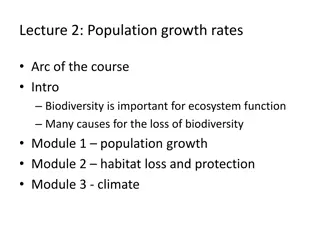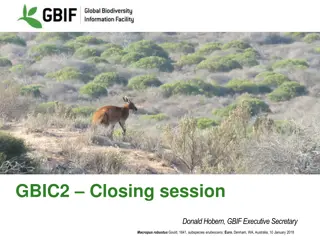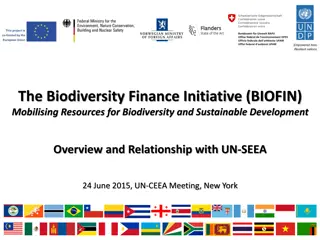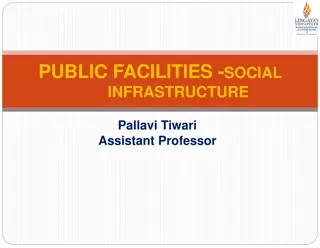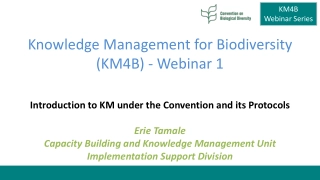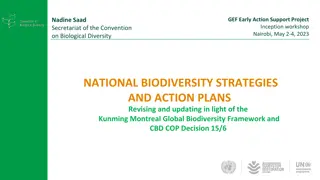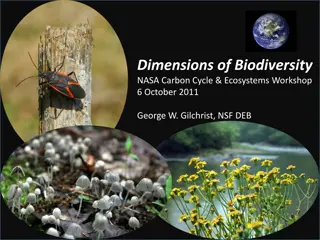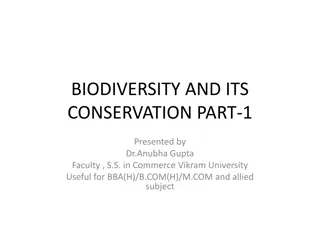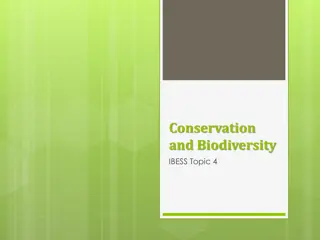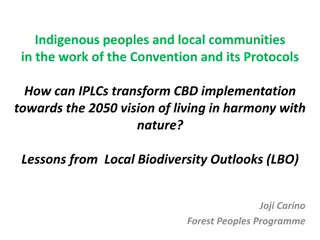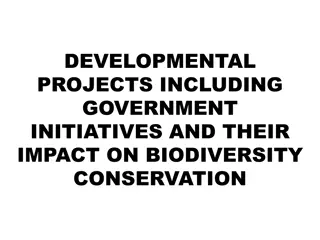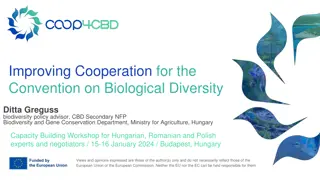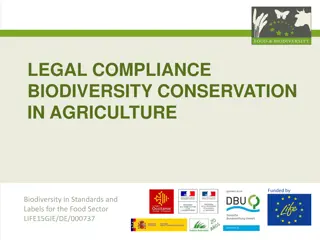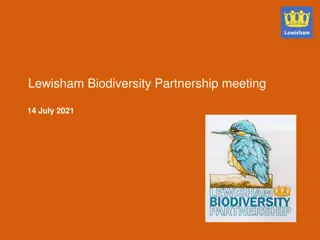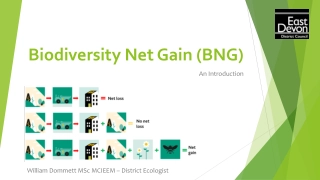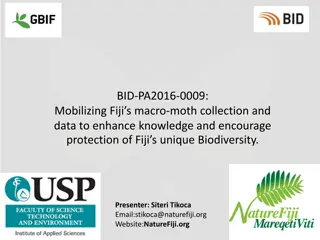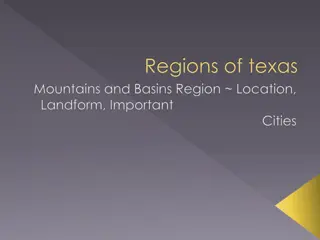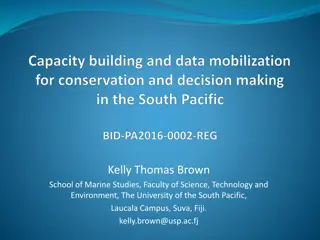Explore the Sundarbans: A Deltaic Region of Unique Beauty and Biodiversity
The Sundarbans, a deltaic region shaped by the Ganges, Brahmaputra, and Meghna rivers, offers a diverse landscape of mudflats, water channels, and mangrove forests. Learn about its physical characteristics, tropical climate with distinct monsoon seasons, and how the delta was formed through sediment deposition. Discover the beauty and uniqueness of the Sundarbans' ecosystem.
Download Presentation

Please find below an Image/Link to download the presentation.
The content on the website is provided AS IS for your information and personal use only. It may not be sold, licensed, or shared on other websites without obtaining consent from the author. Download presentation by click this link. If you encounter any issues during the download, it is possible that the publisher has removed the file from their server.
E N D
Presentation Transcript
The Sundarban Region Presented By-Pranati Manna Department of Geography Bajkul Milani Mahavidyalaya Date:18.11.20222
Physical Characteristics of the Sundarbans The deltaic region of the Sundarbans is a fascinating and intricate ecosystem shaped by the confluence of the Ganges, Brahmaputra, and Meghna rivers. It encompasses a vast expanse of tidal mudflats, water channels, and mangrove forests, creating a dynamic and unique landscape. description of the deltaic region, including its formation, mangrove patterns: Here's a detailed forests, and tidal
Climate of the Sundarbans Description of the tropical climate, monsoon seasons, and temperature variations. Tropical Climate: The Sundarbans lies in a tropical climate zone, which is typically characterized by warm temperatures, high humidity, and abundant rainfall. The region's proximity to the Bay of Bengal influences its climate, as the sea's moisture-laden air interacts with the land, leading to the formation of monsoons. Monsoon Seasons: The Sundarbans experiences two main monsoon seasons: Southwest Monsoon (June to September): During the southwest monsoon, the region receives the majority of its annual rainfall. Moisture-laden winds from the southwest, originating from the Indian Ocean, bring heavy rains to the area. This period is marked by frequent and intense rain showers, often resulting in flooded waterways and wetland areas. Northeast Monsoon (October to February): The northeast monsoon season sees relatively drier and cooler conditions compared to the southwest monsoon. Winds from the northeast bring cooler and drier air, leading to reduced rainfall. While this season is less intense in terms of precipitation, humidity levels remain relatively high. Temperature Variations: The Sundarbans experiences warm temperatures throughout the year, with some variations between seasons: Summer (March to May): Summer is characterized by high temperatures and humidity. Daytime temperatures can range from around 30 to 35 degrees Celsius (86 to 95 degrees Fahrenheit), with occasional spikes in temperature. This period is often accompanied by discomfort due to the combination of heat and humidity. Monsoon Seasons: During the monsoon seasons, temperatures remain warm, but the heavy rainfall and cloud cover mitigate extreme heat. Daytime temperatures typically range between 28 to 32 degrees Celsius (82 to 90 degrees Fahrenheit), with nighttime temperatures being slightly lower. Winter (December to February): The winter months bring slightly cooler temperatures to the Sundarbans. Daytime temperatures range from 20 to 25 degrees Celsius (68 to 77 degrees Fahrenheit), while nighttime temperatures can drop further. This period is relatively comfortable and attracts visitors seeking milder weather.
Formation of the Delta: The formation of the Sundarbans delta is a result of the continuous deposition of sediment carried by the Ganges, Brahmaputra, and Meghna rivers. As these powerful rivers flow downstream from the Himalayas, they carry massive amounts of sediment, which gradually accumulates near their confluence. Over time, this sediment buildup has given rise to the expansive deltaic region, characterized by its low- lying topography and waterways. settles and intricate network of
Rivers and Water Bodies List and description of major rivers, tributaries, and water bodies in the region. Highlight the importance of these water bodies for biodiversity and livelihoods.
Biodiversity Hotspot: The Sundarban is a biodiversity hotspot and a UNESCO World Heritage Site. It is home to a remarkable array of plant and animal species, many of which are adapted to the challenging saline and tidal conditions. Notably, it houses the elusive and endangered Royal Bengal tiger, the iconic species of the region.
Images showcasing the mangrove trees and unique landscape.
Mangrove Forests: One of the defining features of the Sundarbans delta is its extensive mangrove forests. These salt-tolerant trees and shrubs have evolved to thrive in the challenging conditions of the delta, where freshwater from the rivers mixes with saltwater from the Bay of Bengal. The mangrove trees have unique adaptations, such pneumatophores, which allow them to obtain oxygen in waterlogged soils. The Sundarbans mangrove forests are a critical component of the delta's ecosystem. They act as a natural barrier, protecting the coastline from erosion, storm surges, and tidal waves. The roots of the mangroves stabilize the soil and prevent it from being washed away by the tides, helping to maintain the integrity of the deltaic landforms. as aerial roots called
Overview of the Sundarbans Mangrove Ecosystem: The Sundarbans is one of the largest contiguous mangrove forests in the world. Mangroves are salt-tolerant trees and shrubs that grow along coastal areas, serving as a critical buffer between land and sea. The intricate network of roots and tidal waterways in the Sundarbans helps prevent erosion, reduce storm surges, and protect coastlines from natural disasters.
Livelihood and Culture: The Sundarbans plays a crucial role in supporting the livelihoods communities. The region's inhabitants engage in fishing, honey collection, wood harvesting, and agriculture, relying on the ecosystem's resources for their Sundarbans also holds cultural significance, with traditions and intertwined with the natural environment. of local sustenance. The practices deeply
Pictures of boats and water transport used by local communities.
Navigating the Sundarbans Navigation and Transportation: For the local communities residing in the Sundarbans, the water channels are essential for transportation and livelihoods. Traditional wooden boats and small vessels are used waterways, allowing residents to travel between villages, access fishing grounds, and transport goods. The channels are a lifeline for fishing, which is a major source of sustenance and income for the inhabitants. to navigate these
Biodiversity and Habitats: The water channels and creeks of the Sundarbans provide various species of aquatic and semi-aquatic life. These habitats range from mudflats and tidal pools to submerged mangrove roots and shallow waters. The channels are home to a rich variety of fish, crabs, mollusks, and other aquatic organisms. breeding grounds for numerous species. diverse habitats for They also serve as
Biodiversity of the Sundarbans Overview of the diverse flora and fauna found in the region. Mention of iconic species like the Royal Bengal tiger, saltwater crocodile, and various bird species. Images of wildlife and plants native to the Sundarbans.
Conservation Habitat Loss and Fragmentation: Human activities, such as agriculture, aquaculture, and infrastructure development, contribute to habitat loss and fragmentation in the Sundarbans. The conversion of land for human use reduces the available space for mangrove forests and disrupts wildlife habitats. Climate Change Impacts: The Sundarbans is particularly susceptible to the impacts of climate change, including sea-level rise, increased salinity, and extreme weather events. Rising sea levels can lead to saltwater intrusion, affecting both the mangroves and freshwater resources, while cyclones can cause widespread damage to habitats and communities. Human-Wildlife Conflict: The coexistence of humans and wildlife in the Sundarbans often leads to conflict. Tigers occasionally venture into villages, causing fear and posing risks to human safety. Retaliatory killings of tigers can result from such conflicts, threatening the already small tiger population.
Cont Resource extraction, such as illegal fishing and logging, poses a significant threat to the Sundarbans. Overfishing and unsustainable harvesting of mangroves can deplete resources and disrupt the delicate ecological balance. Lack of Infrastructure resources, inadequate infrastructure, and insufficient funding can hamper effective conservation efforts. Proper management, enforcement of regulations, and public awareness campaigns require adequate support and investment. Exploitation: Unsustainable resource and Resources: Limited
sustainable Living in the Sundarbans Local communities residing in and around the Sundarbans have long relied on the unique ecosystem for their livelihoods. The delta's resources and natural environment play a crucial role in providing sustenance, income, and cultural significance to these communities. Here are insights into how local communities rely on the Sundarbans for their livelihoods: 1. Fishing and Aquaculture: Fishing is a primary livelihood activity for many communities in the Sundarbans. The waterways teem with various fish species, crabs, prawns, and mollusks. Local fishermen use traditional techniques and small boats to catch fish, which are then consumed locally or sold in nearby markets. Additionally, aquaculture, including shrimp farming, provides an important source of income for some communities. 2. Honey Collection: The Sundarbans is known for its unique honey, collected from the flowering mangrove trees. Honey collectors venture into the forests to harvest honeycomb, using traditional methods that are passed down through generations. Honey collection provides an additional source of income for these communities, and the honey is often sold in local markets. 3. Agriculture and Farming: Agriculture, though challenging due to the saline environment, is still practiced in certain parts of the Sundarbans. Communities cultivate rice, vegetables, and fruits in patches of fertile land. Livestock farming, including poultry and goat rearing, complements agricultural activities.
Cont. 4. Wood and NTFP Collection: Non-timber forest products (NTFPs) such as wood, thatching materials, and leaves are collected from the mangrove forests. These resources are used for building homes, crafting, and fuel. However, sustainable practices are essential to prevent overexploitation and maintain the health of the ecosystem. 5. Eco-Tourism and Guiding: The increasing interest in ecotourism has led to the emergence of opportunities for local community members to work as guides, boatmen, and hosts for tourists. Guiding tours through the waterways, wildlife spotting, and cultural experiences provide an alternative livelihood while promoting conservation awareness. 6. Cultural and Spiritual Significance: The Sundarbans hold deep cultural and spiritual significance for local communities. Traditional practices, rituals, and beliefs are often intertwined with the natural environment. The forest is considered a source of traditional medicines, and plants from the mangroves are used for various medicinal purposes. 7. Fuelwood and Construction Materials: Mangrove wood is used for fuelwood and construction materials in local communities. Houses are built using mangrove poles and thatch, and wood is used for cooking and heating. 8. Handicrafts and Artisanal Work: Local artisans create handicrafts such as baskets, mats, and other items from mangrove materials. These crafts are not only a source of income but also a way to preserve cultural heritage and traditional craftsmanship. 9. Salinity Farming and Adaptation: Some communities have adapted to the saline conditions by practicing salinity-tolerant agriculture, such as cultivating salt-tolerant rice varieties. These practices help communities sustain their agricultural activities despite the challenging environment.
Examples of traditional practices and eco-friendly initiatives. Traditional practices and eco-friendly initiatives in the Sundarbans region demonstrate the close relationship between local communities and the environment. These practices often stem from a deep understanding of the ecosystem and a desire to ensure its sustainability. Here are some examples: 1. Community-Based Conservation: Local communities often engage in community-based conservation initiatives, where they actively participate in the protection and management of natural resources. This can include establishing community-managed reserves, implementing fishing regulations, and monitoring wildlife activities. 2. Mangrove Reforestation and Restoration: Communities and organizations undertake mangrove reforestation projects, planting new mangrove saplings to restore degraded areas. Reforestation helps combat habitat loss, prevent erosion, and enhance the overall health of the ecosystem. 3. Sustainable Fishing Practices: Fishermen in the Sundarbans practice traditional, sustainable fishing techniques that minimize the impact on fish populations and other aquatic life. These methods include using traditional nets, avoiding overfishing, and adhering to seasonal fishing bans. 4. Turtle Conservation: Some communities actively participate in turtle conservation efforts, protecting nesting sites and working to reduce threats to turtle populations. This includes measures to prevent accidental capture of turtles in fishing gear. 5. Alternative Livelihoods: To reduce pressure on the natural resources of the Sundarbans, initiatives promoting alternative livelihoods have been introduced. For instance, training locals in eco-friendly tourism, handicraft production, and honey collection can provide sustainable income opportunities.
6. Eco-Friendly Farming Practices: In response to the challenging soil conditions and salinity, communities practice eco-friendly farming techniques such as organic farming and agroforestry. These methods help improve soil fertility and reduce the use of harmful chemicals. 7. Waste Management and Recycling: Some communities have adopted waste management practices to reduce pollution. Recycling, composting, and reducing single-use plastics contribute to a cleaner environment and healthier waterways. 8. Renewable Energy Adoption: Initiatives promoting the use of renewable energy sources, such as solar panels and biogas digesters, help reduce reliance on fossil fuels and decrease carbon emissions. 9. Mangrove Conservation Campaigns: Local groups and NGOs organize awareness campaigns and education programs to inform communities about the importance of mangrove conservation and the role these ecosystems play in protecting the coastline. 10. Climate-Resilient Housing: In the face of changing climate conditions and increased vulnerability to storms, some communities are adopting climate-resilient housing designs that incorporate local building materials and traditional knowledge to withstand natural disasters. 11. Rainwater Harvesting: Rainwater harvesting is practiced by some communities to ensure a sustainable supply of freshwater, reducing pressure on local water sources and helping adapt to changing rainfall patterns. 12. Cultural Festivals and Celebrations: Traditional cultural festivals and celebrations often include rituals and practices that emphasize the importance of nature and the ecosystem, fostering a sense of responsibility and respect for the environment.
Ecotourism Information about ecotourism opportunities and their role in raising awareness and generating income. . Nature-Based Tourism: Ecotourism in the Sundarbans focuses on showcasing the natural beauty and biodiversity of the region. Tourists have the chance to explore the intricate waterways, observe wildlife, and immerse themselves in the mangrove forests. Guided tours, boat trips, and nature walks provide up-close experiences with the ecosystem. 2. Wildlife Watching: One of the main attractions of ecotourism in the Sundarbans is the opportunity to spot iconic species such as the Royal Bengal tiger, saltwater crocodile, spotted deer, and various bird species. Responsible wildlife watching practices ensure minimal disturbance to the animals and their habitats. 3. Cultural Experiences: Ecotourism programs often include interactions with local communities, allowing visitors to learn about traditional practices, art, and culture. This provides insight into the close relationship between people and the environment. 4. Bird watching and Photography: The Sundarbans is a haven for birdwatchers and photographers. Its diverse bird species, both resident and migratory, offer unique opportunities for enthusiasts to capture stunning images and observe avian behaviors. 5. Conservation Education: Ecotourism activities in the Sundarbans are designed to educate visitors about the delicate balance of the ecosystem, the importance of mangroves, and the need for conservation. Interpretive signage, guided talks, and interactive experiences raise awareness and foster a sense of responsibility toward environmental protection.
6. Economic Benefits for Communities: Local communities benefit economically from ecotourism through various means. They provide services such as guided tours, boat rentals, accommodation, and traditional cuisine. This diversification of income sources can help reduce dependence on activities that may harm the environment. 7. Incentive for Conservation: When local communities see economic benefits from ecotourism, they are more likely to actively engage in conservation efforts. A well-managed ecotourism program aligns the interests of both conservation and community development. 8. Support for Conservation Initiatives: Revenues generated from ecotourism can be reinvested into conservation projects and community development. These funds can be used for habitat restoration, anti-poaching efforts, education programs, and infrastructure improvements. 9. Preserving Traditional Knowledge: Ecotourism can create opportunities for local communities to share their traditional knowledge and practices with visitors. This exchange helps preserve cultural heritage and promotes a deeper understanding of the symbiotic relationship between humans and nature. 10. Sustainable Practices: For ecotourism to be successful and beneficial in the long term, it must prioritize sustainability. Measures such as limiting visitor numbers, minimizing ecological impact, and adhering to ethical wildlife viewing practices are crucial.
Conclusion Emphasize the importance of safeguarding the Sundarbans for future generations Safeguarding the Sundarbans for future generations is not just a matter of ecological concern; it is a profound responsibility that transcends time and borders. The unique and intricate ecosystem of the Sundarbans holds significance that extends far beyond its immediate boundaries. Here's why preserving the Sundarbans is crucial for the well-being of future generations: 1. Biodiversity and Ecosystem Services: The Sundarbans is a treasure trove of biodiversity, harboring species found nowhere else on Earth. Its mangrove forests act as nurseries for marine life, providing food and shelter for various species. The intricate web of life in the Sundarbans contributes to essential ecosystem services like pollination, water purification, and climate regulation that are vital for sustaining life. 2. Climate Change Mitigation and Adaptation: As a carbon sink, the Sundarbans helps mitigate climate change by absorbing carbon dioxide from the atmosphere. The mangroves also serve as a buffer against rising sea levels and storm surges, acting as a natural shield that protects coastal communities and their livelihoods.
3. Cultural and Traditional Heritage: The Sundarbans hold deep cultural and spiritual significance for local communities. Traditional practices, beliefs, and knowledge are intricately linked to the ecosystem. Preserving the Sundarbans ensures that these cultural legacies are passed down to future generations, maintaining a connection to the land and fostering a sense of identity. 4. Scientific Discovery and Education: The Sundarbans provide a living laboratory for scientific research and discovery. Studying its unique flora and fauna can lead to breakthroughs in fields like ecology, biology, and climate science. Conserving the Sundarbans allows future generations to explore, learn, and benefit from the knowledge gained. 5.Biodiversity Conservation: The Sundarbans is a haven of biodiversity, housing a multitude of species found nowhere else. By protecting this ecosystem, we ensure that future generations can witness the intricate web of life and experience the wonders of nature. 6.Economic Prosperity: Sustainable utilization of the Sundarbans' resources provides economic opportunities for local communities and the wider region. By preserving these resources, we secure livelihoods and ensure that future generations have access to sources of income and well-being. 7. Education and Inspiration: The Sundarbans offers unparalleled educational opportunities. It can inspire future generations to appreciate the beauty of nature, understand the intricate relationships that sustain life, and motivate them to become stewards of the environment. 8. Moral Responsibility: As custodians of the Earth, we have a moral obligation to leave behind a world that is as diverse and vibrant as the one we inherited. Safeguarding the Sundarbans is a testament to our commitment to the well-being of future generations and an expression of our values.



